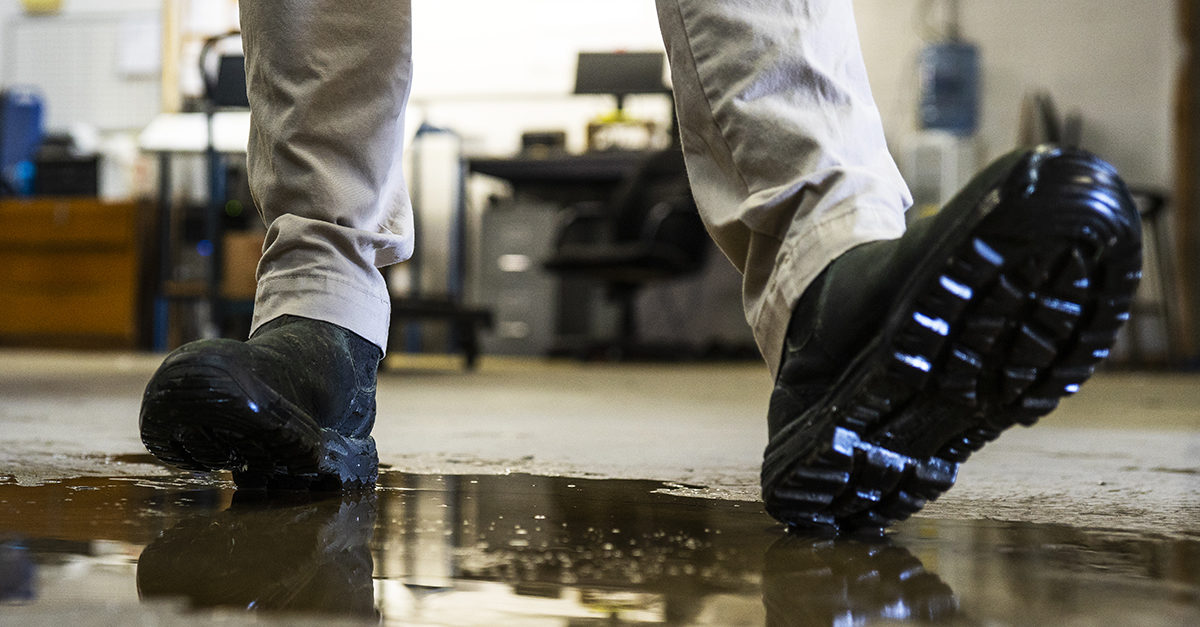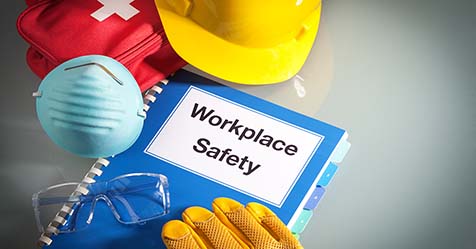Mark Warner, education manager with ISSA’s Cleaning Management Institute (CMI), recalls a worker who wore sneakers to strip a floor. The worker’s sneakers and shoes became soaked with the stripping solution, but he finished the job without stopping to change his footwear, which eventually dried.
Later, when he removed his shoes and socks, he realized he had made a huge mistake. Several layers of his skin had peeled off with them. The worker had severe burns and needed skin grafting.
“When you get a burn from a highly caustic alkaline substance, such as floor strippers, the substance burns deeply below the surface of skin with all the nerves. You often don’t realize what has happened until you try to remove your shoes and socks,” Warner explained. “It’s very different from an acid burn, which causes immediate pain.”
This is just one example of how personal protective equipment (PPE) goes beyond safety goggles, masks, and gloves; some jobs — such as floor stripping — require PPE from head to toe. Let’s take a look at examples of where PPE is appropriate, starting with the feet and working our way up.
Feet
Proper footwear will not only prevent workers from saturating their socks with cleaning and stripping solutions, it also will keep them from falling on slippery floors. According to Warner, workers need to wear sturdy, rubber-soled shoes or boots. “If I see workers with sneakers or sandals, that’s no good. I’ll send them home,” he said. Warner also recommends footwear with floor stripping pads on the soles to help provide traction.
Rubber galoshes or rubber-soled shoes also protect workers from electric shock while walking on wet floors. “Think about using a 175-rpm floor machine plugged into a wall circuit while scrubbing or stripping a wet floor,” Warner said. “I will not allow someone to do wet work on a floor without proper shoes.”
Hands and Arms
“It is never appropriate to not wear gloves as a professional cleaner,” Warner says. Any task that requires the use of cleaning solution requires gloves; that may include tasks pertaining to restroom care, carpet cleaning, floor care, even window cleaning. “In addition, the [U.S. Department of Labor’s Occupational Safety and Health Administration (OSHA)] requires professionals to protect themselves from bloodborne pathogens when cleaning up blood or bodily fluids.”
Vinyl disposable gloves are the most common and most cost-effective choice for jansan professionals, according to Andrew Sheridan, marketing manager of retail and specialty for Protective Industrial Products. Nitrile or latex gloves also are popular choices, with many workers preferring nitrile because it has better chemical resistance and does not trigger allergies.
Some disposable gloves feature a textured design, which channels away oils and detergents and gives wearers better grip when working in wet or slippery conditions, Sheridan said. In additional to increased dexterity, these gloves offer comfort and breathability. For more heavy-duty tasks, such as outdoor work, nondisposable work gloves are preferable. Whichever type you choose, gloves will protect your hands from cuts as well as irritation, rashes, and chemical burns.
Lungs
Workers in the jansan industry are at risk of breathing contaminated air due to frequent exposure to bleach, ammonia, and other cleaning chemicals. Routine maintenance tasks require workers to use paint, varnish, stain, and stripping solvents, while landscaping duties expose workers to pesticides and insecticides.
Respirators cover the wearer’s nose and mouth and come in various forms to protect people from breathing in a variety of airborne contaminants. Disposable dust masks protect workers from nontoxic particles such as pollen, while reusable respirators with replaceable filters on each side protect from heavier airborne contaminants such as oil-based paints.
Nondisposable respirators require regular care to keep them working well. Sheridan said some come in special packaging, which helps the respirators maintain their shape and protects them from the elements.
Ears
Prolonged exposure to loud noises such as vacuums, leaf blowers, and lawn mowers can lead to permanent hearing damage. Ear protection is available in the form of disposable ear plugs that fit in the ear canal as well as ear muffs that fully cover the ear.
Some earmuffs provide high-tech features, such as built-in radios for jamming to tunes while working, microphones that allow for better communication between coworkers, and Bluetooth technology that allows hands-free mobile phone use. Level-dependent ear muffs allow workers to hear regular noises in quiet environments but block loud noises. Active noise cancellation ear muffs reduce low-frequency droning sounds, such as humming from engines and air conditioners.
Eyes and Face
Eye protection is available through safety glasses, safety goggles, and face shields. They all protect workers from chemical splashes to the eyes, with goggles providing a tighter fit than glasses and shields providing complete face protection. Like gloves, disposable face shields are ideal for protecting workers when they are cleaning areas that may be contaminated with blood or bodily fluids.
“Exposure to bloodborne pathogens through an open wound, membrane, through the eyes, nose, or mouth can result in workers contracting HIV or hepatitis, life-changing diseases that need to be avoided at all events,” Warner said.
Safely glasses with adjustable temples change size so workers can get a better fit. Glasses with indoor/outdoor lenses adjust to lighting so workers don’t need to change their eye protection when they enter a facility after working outdoors. Fogless glasses also have a special coating on the lens that prevents them from steaming up in hot or steamy environments.
Protect PPE so it Can Protect You
Sheridan recommends users inspect respirators regularly for holes or cracks and to store them in a location protected from the weather and extreme temperature changes. Make sure the seal is not broken in both safety goggles and respirators, because the seal is what keeps the PPE tight against the user’s face.
Use gentle solutions to clean and disinfect eyewear, respirators, and ear muffs, Sheridan said. Make sure to follow the manufacturer’s instructions for cleaning and care.
Check nondisposable gloves regularly for punctures or tears. “If properly cared for, PPE will last for a while, but you won’t get the proper benefits if you use it past its lifespan when it’s deteriorating,” he said.
Set a Good Example
The latest PPE features fit, fashion, and functionality. If your employees still won’t wear it, Sheridan believes the inspiration to do so comes from the top down. “If management is making PPE a priority by enforcing its use and supervisors are making sure to wear it themselves, that trickles down to the employees,” he said.



